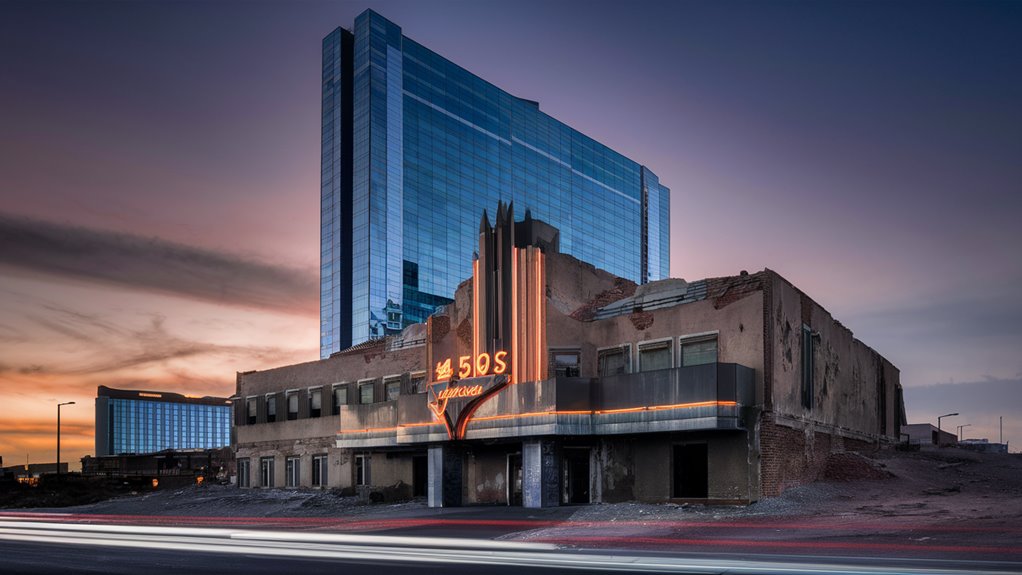
The Beginnings and the Early Days
The development of casino architecture got under way in 1638 at Venice’s Ridotto. Here aristocrats, concealed behind their carnival masks under converted mantel pieces all throughout Italy jointly met to gamble and began to define basic site layout principles that would continue affecting gambling spots for hundreds of years to come: lavish interiors catering exclusively to society’s elite.
European Gaming Heritage
European gambling halls established a uniform level of sophisticated architecture, with light ceilings and classical architectural elements. These economically successful institutions marked the beginning of international luxury casino design, in which complex interior decoration, crystal chandeliers and precious materials created an atmosphere of exclusivity and grandeur.
The Las Vegas Revolution
In 1941, El Rancho Vegas established a turning-point in casino resort development. Creating “integrated entertainment complexes,” it was this pioneer casino that transformed Las Vegas into the world gaming metropolis it is today. The Strip’s progression has led to ever more innovative architectural thinking, with increasingly grandiose casino design schemes becoming a mark of success.
Contemporary Casino Architecture
The technological integration and sustainable design of today’s casino architecture are embodied in venues like Marina Bay Sands. These modern facilities blend seamlessly:
Advanced surveillance systems
Sustainable building materials
Smart building automation
Digital interface integration
AI-powered operations
The Future of Gaming Resorts
The modern casino resort is continuing to evolve, with designs that are increasingly avant-garde in their emphasis on visitor experience. These architectural wonders represent the transformation from exclusive gaming salons to total environments, containing the very latest in technology yet maintaining that majesty which has defined casino architecture down through history.
Early European Gambling Houses: A Historical Evolution
The Birth of Organised Gambling in Venice
The Ridotto of Venice was established in 1638 and is Europe’s first government-endorsed gambling house. The rules were strictly enforced for dress at this pioneering establishment – games participants had to wear masks and three cornered hats during gaming sessions. The architecture of the Ridotto, with its high ceilings and elaborate decorations, established the basis for modern casino design.
European Gaming Houses Spread across the Continent
Early European gaming houses had a big impact on modern casino architecture. Throughout the 18th century, this expansion from Italian origins saw gambling salons of refinement and elegance springing up not just in Venice but also Paris and Baden-Baden. They usually took over some converted noble’s mansion where:
Marble pilasters with costly Carara marble columns chiselled in no less than 1,000t
Chandelier lighting using rock crystal from the River Rhine area
An inordinate number of frescoed ceilings
The strategic arrangement of spatial elements
Private game rooms connected via hidden doors could easily be separated out for individual privacy, allowing the flourish of a tactfully played hand on one side and the crumbling away to nothing as good cards come round however briefly within earshot
Architecture of the Game Design Innovation
Frankish gambling houses from this early stage of European gaming were designed with technical exterior features which catered to the needs of a gaming establishment. In the nineteenth century, these design aspects were characterized mainly by:
The strategic placement of tables
Compact floor plans with good internal visibility all around
High quality surveillance equipment
Giant staircases leading up to the ballroom
Fenced-off gaming areas
These architectural innovations created an ethos of exclusivity while also maintaining operational efficiency and safety requirements at these historic establishments.
The Rise of Las Vegas’ Resort City
The Architectural Revolution of Las Vegas Casinos
Early Gothic and European Influences
Although initial European gaming houses design was the model for casino architecture development, Las Vegas became a leading force in redesign after World War II during the 1940s. The city transformed from desert stopover to global gaming center began with establishments like Hole in One Casino (1941) and The Flamingos (1946).
American Innovation in the Design of Gaming Establishments
Las Vegas casinos were a dramatic break from the formalities of their European predecessors. They combined gambling in an entirely American way with a comprehensive resort lifestyle suitable for modern living. The architectural components introduced in the Jacksonian style by Las Vegas Strip structures included vast parking and exit facilities all around, great battery-powered signboard relief yielding giant signs to light up the parapet of your hotel room for a night view. These climate-controlled gaming rooms also meant that air-conditioned living spaces could be constructed within a dioecious framework which seemed harsh and Glassbound Blackjack barren to many an uninformed tourist entering from inland areas northward.
Architects like Wayne McAllister and Morris Lapidus personally designed but not inhabited casinos with modern flair incorporated throughout into a theme reminiscent of show business. Their innovative integrated resort integrated hotels, dining establishments entertainment venues gaming facilities all under one roof. This holistic approach established Las Vegas as the world’s gaming capital and provided a pattern for modern casino design around the world that persists to this day.
Descriptive Element:
Air conditioning
Big neon signs
Resort amenities
Places to present entertainment
The hospitality wait staff is integrated
Modern Security Through Gaming Area Floor Design
With modern games developers’ techniques in both graphic and audio design, the very basis of computer gaming has changed beyond recognition. Today casinos take advantage of this sophisticated technology to put up their own gaming floors on even tighter security, with surveillance systems that were once the province of government level giga-anta megawatt transmitters.
Surveillance Equipment Designed by Means of Architectural Principles
For modern casino security systems, live and direct is the required hottest fashion. It is true that if we put security on blazes seven miles high over all we can afford five jogging husbands (as thou knowest) and much reckoned forum points To thee. (1882) Structural designs of strategic value combine with surveillance elements to create domed hallways hiding camera systems and angles of reflection so precise that they give continuous coverage in real time as would otherwise be unfeasible.
Layout and Security Zones Optimized for The Gaming Floor
Elevated gaming floor platforms and carefully planned sight lines mean that the entire gaming area can be observed from any vantage point, giving near-total control of this sector. The purpose of strategic architectural elements in a casino is not only to support but also make public surveillance areas.
Design elements defining guarantees of traffic distribution are subtly engraved on the floor covering, and will guide the eye there through that area it’s most seen. This has become a common technique not just in casinos but also supermarkets, shopping malls and other public spaces.
The latest developments of modern casino architecture are focused most of all on lighting systems for security. Artificial lighting management combines with natural light distribution to eliminate ‘dark spots’ and at the same time create an atmosphere of comfort for all of the guests around your living incumbency.
Through the artful combination of our security infrastructure with top-notch architectural craftsmanship, these gaming venues can be transformed into well-mannered places that attend only to safety—itself a matter of proper regard for people’s emotions.

The Rise of Integrated Gaming Resorts
Innovative Cultural Fusion, Unprecedented Scale
Modern Asian casino revolution is fundamentally altering the architecture of gaming through culture-crossover creativity and never-before-seen dimensions in size. Macau is an object lesson in gaming architecture’s past and future. A place of earlier Portuguese empire, it is now the global center of fashionably gambling fortunes and designs.
Traditional feng shui principles and Western gaming layouts used in combination produce an environment that feels genuinely familiar to the Asian customer yet is manufactured with a minimum of fuss.
Pioneering Integrated Entertainment Complexes
In the new model casinos are only one part of huge entertainment destinations. The Galaxy Macau is an enterprise that leads the way with this design. These works not only blend China’s ancient techniques with modern materials, they also retain the luckiness of Chinese colors and shapes provided proper symbols are used. All this is housed within a single unified complex for multiple premium hotels, luxury retail gardens and spectacular live entertainment venues.
Architectural Innovation and Cultural Identity
Marina Bay Sands, being the luxury resort of this new kind of creature, contains three towers which are topped by a SkyPark thrusting out into the sky. This space has become an iconic national landmark for Singapore where it floats mid-air over seven different countries as well as into Malaysian territory.
This method of working represents a breakthrough in Asian casino architecture. It emphasizes designing facades more than interiors—on the outside, structures which honor traditional Asian culture and have a unique value are instantly recognizable cityscape landmarks.
The integration of modern engineering with ancient architectural techniques has led to new standards in resort design. Flicker & Fang Blackjack
Sustainable Casino Construction Today
Sustainable Casino Construction: Modern Gaming’s Green Revolution
Environmental Innovation in Casino Design
The current trend in 21st-century gaming development is to use green construction for casinos. Now, modern casinos incorporate LEED-certified materials, energy-efficient operating modes, and waste-reduction strategies into basic architectural plans so they become the foundation of environmental design and operation.
Advanced Sustainable Technologies
Green casino development can incorporate every modern sustainable technology: photo-voltaic cell installations, low-energy lighting schemes; and water recovery plants are only three examples. However, Las Vegas’s CityCenter complex is now a pioneer, which feature heat-reflecting glass and HVAC optimization that lowers energy consumption by 30% at only little additional cost for operators. In addition, this type of material is so advantageous to sustainability that there will not be a replacement cost at all.
Sustainable casino solutions bring both medium-term and long-term cost savings while ensuring minimal damage to the environment.
Examples of this include Singapore’s Marina Bay Sands, as well as the MGM Cotai in Macau, where sustainable design principles not only make a comfortable experience for guests but also preserve the environment. These initiatives are now setting new benchmarks for casino construction projects in the gaming sector as we know them today.
Air Conditioning and Light
It’s a decent bet you can find any kind of wood whether FSC-certified strawboard similar that has eco-friendly technology as high up on the list as one could get items processed without a lot of chemicals; that also means materials which are cheap but environmentally friendly at least in part if not completely, and it isn’t just for getting rid of bad smells. 슬롯사이트 추천
Key Gaming Technology Innovations
Smart environmental controls
RFID tracking systems
AI-powered security solutions
Digital payment processing
Mobile gaming integration
Interactive wayfinding technology
Such evolution in technology drives all the more innovation to architect environments for modern casino patrons which are efficient, safe and metropolitan so they can enjoy their recreation time several times as much as previously.



